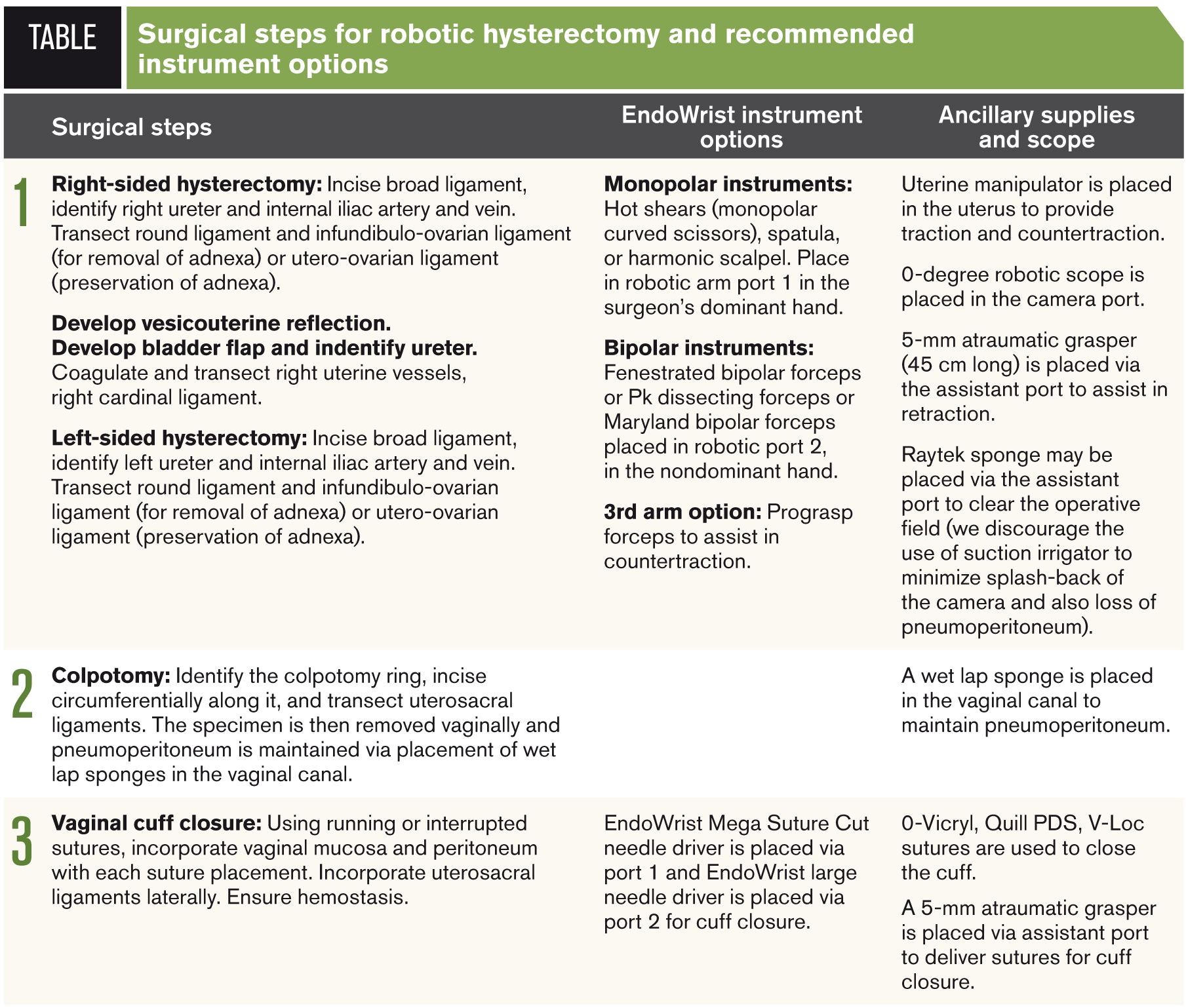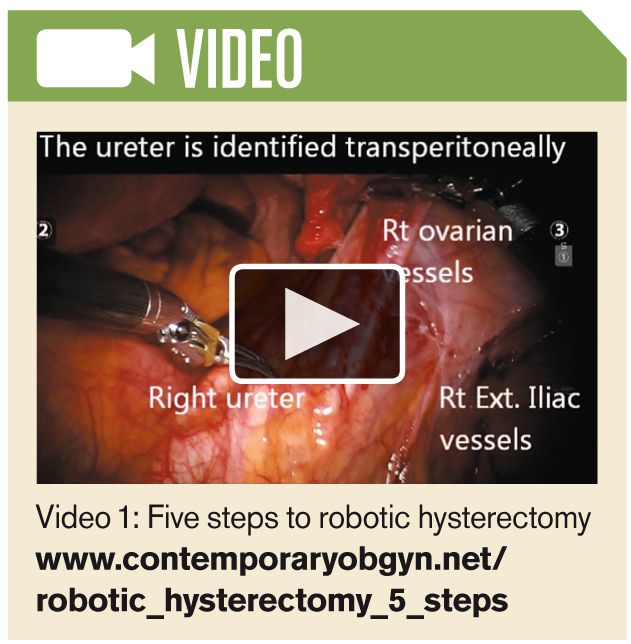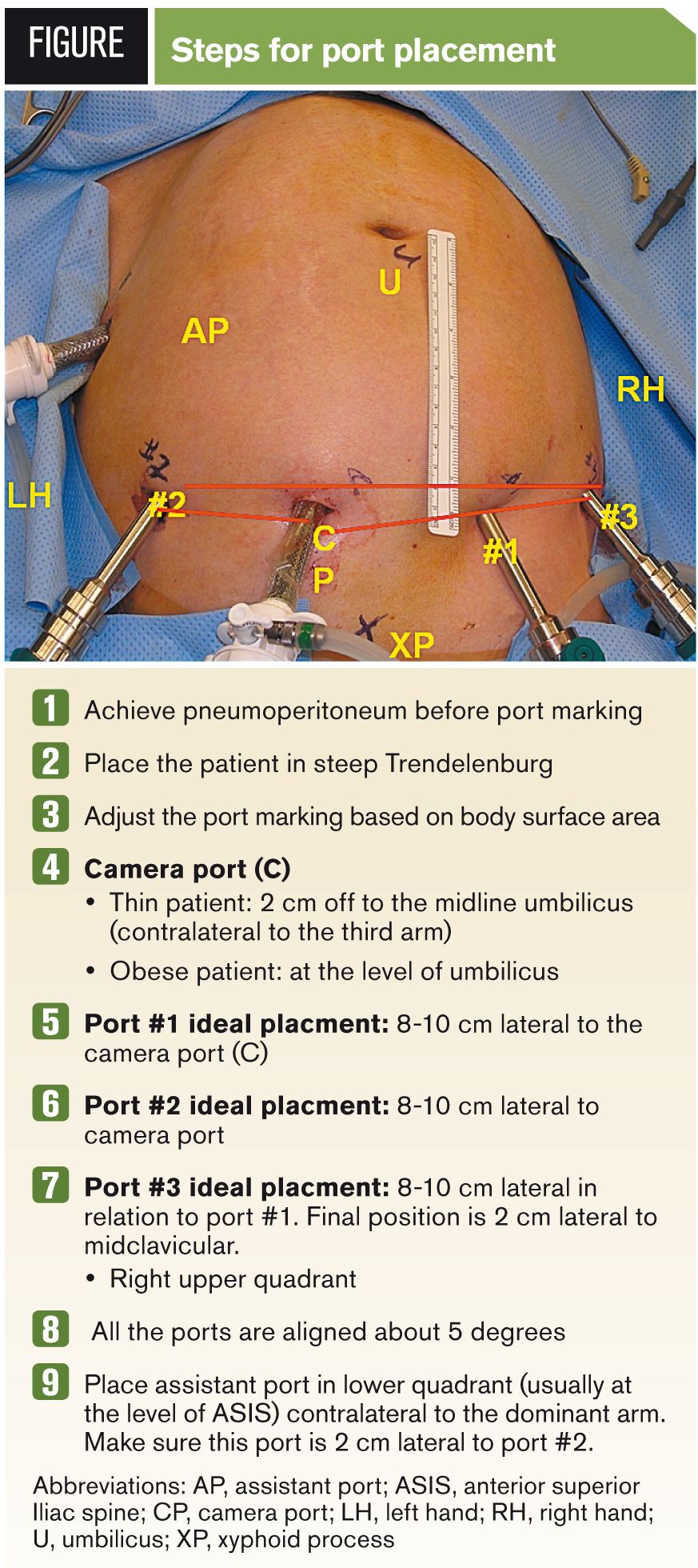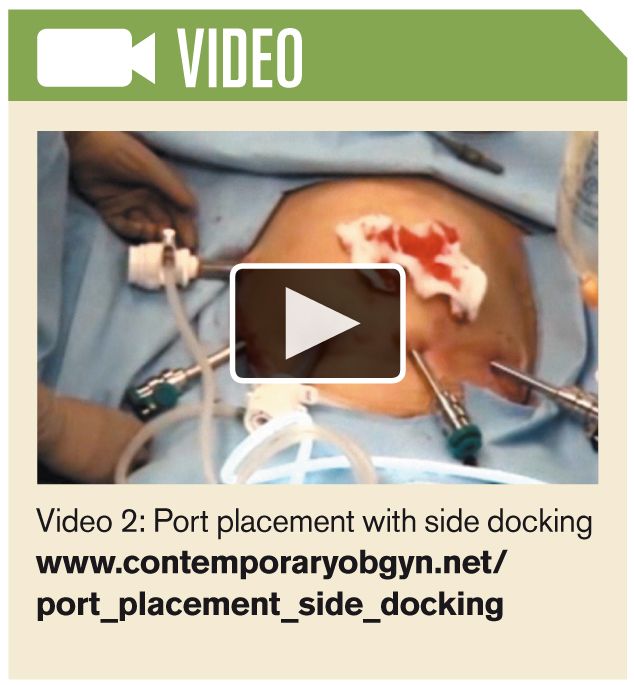Robotics in gynecologic surgery
The surgeon's guide to positioning, port placement, safety, efficiency, and payment.

Dr. Lim is Medical Director of gynecologic oncology and robotic surgery at the Center of Hope, Reno, Nevada, and Medical Director of the Minimally Invasive Surgical Institute, Renown Regional Medical Center, Reno, Nevada.
He has no conflict of interest to report with respect to the content of this article.
The introduction of da Vinci robotic surgery (DVRS) to the field of gynecologic surgery has made minimally invasive procedures a possibility for a growing number of patients for whom open surgery was once the only option. Laparoscopy historically has been proven to have advantages over open surgery including shorter hospitalization, faster recovery, less blood loss, better cosmesis, and fewer complications.
Applications for laparoscopic vaginal procedures, however, can be limited by complex pathology. Traditional laparoscopy also relies on hand movements that are counterintuitive and instruments with a limited range of motion that often require ergonomically challenging positions. Both vaginal and traditional laparoscopy can also be challenging because of limited operative field visualization and the requirement for a skilled surgical assistant. Such challenges can lead to fatigue and frustration for a surgeon. Consequently, the rate of abdominal hysterectomy remains over 60% while the rate of vaginal hysterectomy remains stagnant at 22% and laparoscopic hysterectomy at 14% despite the existence of these minimally invasive surgical approaches for over 20 years.1,2
Robotic surgery became a reality when the US Food and Drug Administration (FDA) approved AESOP (Automated Endoscopic System for Optimal Positioning), a single robotic arm that was controlled by voice command. In 1999, 2 robotic arms were added to create the ZEUS robotic surgical system, which also introduced the concept of a surgeon operating at a distance from the patient, now known as telesurgery. This technology was further advanced by Intuitive Surgical, which added a console that allows the surgeon to view the operative field through a screen and direct movement of instruments through robotic arms via finger graspers and foot pedals. It has a high-definition camera vision system that provides a 3-dimensional image of the operative field controlled via foot pedals and arm movements. In addition EndoWrist instruments allow 7 degrees of freedom, mimicking natural hand and wrist motions intuitively, much like open surgery.
In April 2005, the FDA approved robotic technology for gynecologic surgery. Since then the adoption of robotic surgery has been rapid. Several academic teaching hospitals have reported a dramatic decrease in both open hysterectomies and traditional laparoscopic surgeries while the rate of robotic surgery increased dramatically.3,4
Safe use of robotic surgery
Surgeons who want to adopt robotic surgery must be properly trained, familiar with the tools, and committed to safe use of the technology. Currently there is no formal clinical pathway recommended by any of the gynecologic societies or the American College of Obstetricians and Gynecologists (ACOG), with the exception that ACOG recommends supervision or assistance by an experienced colleague until satisfactory competency has been achieved.5
One researcher has proposed a detailed clinical pathway based on the results of informal surveys from experienced robotic surgeons, which involves didactic study, dry laboratory on the robotic platform or simulator, case observation, and a live animal laboratory model, followed by proctored cases.
A minimum of 3 simple cases proctored by an experienced robotic surgeon was proposed for the first 3 cases, and at least 12 to 15 simple robotic surgical cases should be performed before an advanced case is attempted.6 A detailed clinical pathway should be adopted to safely employ this technology and minimize complications.
Obtaining robotic surgery efficiency
Achieving robotic surgical efficiency involves team effort, preparation, and commitment. A coordinated team effort is imperative to achieving robotic surgical efficiency. The team consists of a robotic coordinator, surgeon, first assist, a circulator, surgical tech, and an anesthesiologist. The robotic coordinator troubleshoots for potential system failure and provides system maintenance. Each team member is assigned specific tasks. For example, the bedside assistant manages the respective robotic arms while a second assistant manages the uterine manipulator. There should be clear and constant communication between these bedside assistants and the surgeon to minimize wasted movements. In addition, the bedside assistants should be knowledgeable in managing robotic arm collisions.
Commitment to training is essential for a surgeon who wants to become proficient in robotic surgery. How many robotic surgical cases are required to achieve efficiency with the technology remains unclear. A retrospective cohort study, however, reported that between 25 and 50 cases are required to achieve proficiency in the early learning curve for both benign and malignant hysterectomies.7-9 Furthermore, it is important to recognize that the learning curve is different for each part of a robotic surgical procedure- port placement, docking, hysterectomy, cuff closure, and lymph node dissection.7,10
Early adopters of robotic surgery should commit to performing multiple consecutive robotic surgical cases to develop and maintain skills such as multiple clutching, tracking, and wristing instruments to become efficient. Use of a computerized robotic simulator, similar to the inflight-simulators used for pilot training in aviation, is helpful for maintenance of robotic surgery skills and proficiency.6
Finally, clear, consistent steps for each specific surgical procedure should be adopted so that team members can become familiar with each procedure with repetition. One such proposal for procedural steps for a robotic hysterectomy is outlined in the Table (see also Video 1).


www.contemporaryobgyn.net/robotic_hysterectomy_5_steps
Patient positioning and robotic port placement
Patient positioning
For robotic surgery, a patient is placed in a low lithotomy position with legs padded in yellow fin stirrups (Allen Medical Systems) in a Trendelenburg position. Arms are tucked and padded to minimize any nerve injury. Shoulder braces can be used to minimize the known risk that a patient in steep Trendelenburg will slip from the table. The braces should be well padded to minimize brachial plexus injury. It is important to note that a steep Trendelenburg position for more than 3 hours may predispose a patient to potential brachial plexus injury, corneal abrasions, laryngeal edema, cerebral edema, and posterior ischemic optic neuropathy.10 The etiology of these potential intraoperative complications is unclear. It is believed, however, that prolonged steep Trendelenburg position may be a contributing factor, particularly in patients with a body mass index greater than 30.
Port placement
Proper port placement is imperative not only to minimize potential complications but also because it will dictate the success of the procedure. Robotic surgical platforms have the option of using a 2-arm system or a 3-arm system. A 2-arm system can be used to minimize cost; however, when employing the 2-arm system a surgical assistant is required to assist in the operation. We prefer to utilize all 3 robotic arms with the 3rd arm providing static counter traction in place of the assistant surgeon. The steps for port placements are outlined in the Figure.

Step 1: Planning and adjusting for body surface. Adjustment of the port placements according to the patient’s abdominal wall body surface area is imperative. Typically, the camera port is placed first at the midline at the level of the umbilicus. The robotic ports are then placed 8 to 10 cm lateral to the camera port. In a thin patient, however, it is important to place the camera port 2 cm lateral to the umbilicus, contralateral to ports 1 and 3. This port placement adjustment is important for port 3 to avoid the flank region, which would limit arm function.
Our preference is to place ports 1 and 3 in the right upper quadrant mainly because of the surgeon’s right-handed dominance. Port 2 is placed in the left upper quadrant while the camera port is placed between port 1 and port 2 (Figure). If the surgeon is left-hand dominant, then ports 1 and 3 can be placed in the left upper quadrant while port 2 is placed in the right upper quadrant.
An incision is made where the camera port will be placed at the midline and pneumoperitoneum is established followed by demarcation of port placements. A 12-mm trocar is then placed at the camera port site and initial exploratory laparoscopy is performed to evaluate the peritoneal cavity for adhesions. We prefer to use a separate 5-mm laparoscope to perform this function. The 5-mm laparoscope facilitates maneuverability in the event that adhesiolysis is required.
Step 2: Placement of assistant port in left lower quadrant. The assistant port is placed after the camera port. The assistant port is placed inferiorly in the left lower quadrant 2 cm ipsilateral to port 2 at the level of the anterior superior iliac spine. Placement of the assistant port in the left lower quadrant has several advantages: it allows the surgeon to visualize the upper abdomen during placement of instruments through the robotic ports thereby minimizing internal organ injury; it allows the surgeon to track and assist in removal of suture with needles to prevent a lost needle; and it minimizes “chopsticking” with the robotic arms at the time of pelvic dissection. In the event that robotic ports are displaced when pneumoperitoneum is lost during surgery, utilization of a conventional 5-mm laparoscope via assistant port allows diagnosis of any robotic port problems without re-docking the robotic camera.
Step 3: Placement of robotic ports. Employing a separate 5-mm conventional laparoscope via the assistant port allows for safe placement of robotic ports and instruments under direct laparoscopic visualization. The robotic ports are generally placed such that they are in a straight line to minimize arms clashing. The ports are generally placed at the level of the umbilicus. They should, however, be adjusted cephalad, to accommodate complex surgical cases such as large fibroids, obese patients, or para-aortic lymph node dissection (see Video 2).

www.contemporaryobgyn.net/port_placement_side_docking
Once the ports are appropriately placed, the robot is docked to allow attachment of robotic arms to the robotic ports. Depending on the intended surgical procedures, the robot is docked either at the patient’s hip (also called side docking), shoulder, or perineum. For a majority of pelvic surgical procedures, side docking is recommended as it allows for vaginal access. If side docking is preferred, the robot should be docked ipsilateral to ports 1 and 3.
Instrumentation
Proper instrumentation is critical to perform robotic surgery successfully. A bipolar grasper or PK dissector is placed in port 2 in the contralateral nondominant hand to grasp, coagulate, and seal vessels. A unipolar spatula, hot shears (scissors), or harmonic scalpel is typically placed in port 1 in the dominant hand to facilitate dissection. We prefer to use the unipolar spatula in the dominant hand; however, the disadvantage is that it does not allow for spreading and separating the tissue to identify tissue planes. The hot shears or harmonic scalpel is a better instrument if this surgical technique is desired. The advantage of the harmonic scalpel is that the blunted blades allow for tissue grasping, which cannot be accomplished with monopolar hot shears. Prograsp forceps are typically placed via port 3 to provide static counter traction to facilitate dissection.
Surgical tips to avoid complications
Complications of robotic surgery can occur as a result of malfunction of the robotic system, instrument failures, the surgeon’s inexperience, trocar injuries, and poor robotic surgical techniques. The incidence of robotic system failure during surgical procedures has been reported to be 2.4% for robotic general surgical procedures and 4.5% for robotic urologic procedures and gynecologic oncology procedures.11-13 No mortality has been reported and the need for conversion to laparoscopic or open procedure was reported to be less than 1%.
The primary instrument failure that has been reported is insulation failure on the robotic monopolar scissors tip cover accessory (MSTCA). This insulation device prevents current leak from surfaces on the instrument other than the scissors tip. In a prospective analysis, researchers reported a nearly 40% visible insulation defect and 33% electric arcing problem defect in the first-generation MSTCA.14 They found that electrical arcing increases with greater wrist angulation and higher power setting. The insulation failure was seen after a single use of the instrument. The study did not find this in the second generation of MSTCA. Other investigators found a similar insulation failure rate (33%), but reported that the incidence of insulation failure dramatically increases to 80% after 10 uses of the instrument.15 Thus it is important to be cognizant of this potential complication if monopolar scissors is the preferred instrument for dissecting and coagulation.
Intraoperative complications have been well documented for robotic surgery done for benign gynecologic procedures such as adnexectomy, myomectomy, benign hysterectomy, and sacrocolpopexy, as well as malignant hysterectomy, surgical staging for endometrial cancer, radical robotic hysterectomy, and ovarian cancer debulking.6,16-32 In retrospective studies, the reported incidence of complications for robotic surgery is 2% to 10% and the complications identified include bowel, vascular, bladder, ureteral, and nerve injuries. Incidence of complications for robotic surgery is lower than for open surgery; but outcomes were no different in a retrospective comparison of perioperative outcome for robotic versus laparoscopic hysterectomy.33
Another prospective, randomized, controlled study also showed no difference in complications between robotically assisted total laparoscopic hysterectomy and conventional total laparoscopic hysterectomy.34 In all these reported cases, it was difficult to ascertain the factors that contributed to the complications. Possible factors include lack of communication between the surgeon and the bedside assistant when exchanging instruments, lack of tracking instruments, thermal injury from coupling effect, and loss of haptic feedback from excessive force of traction or counter traction with the robotic arms.
Finally, inexperience and poor judgment in case selection during the early learning curve may lead to complications. Thus proper training on the robotic platform and appropriate uncomplicated case selection in the early learning phase is encouraged. The surgeon should have the ability to troubleshoot and be aware of potential instrument defects. Proper robotic surgical techniques such as communicating with the bedside assistant in exchanging instruments, tracking instruments, wristing instruments to avoid energy coupling effect, and avoiding grasping excessive tissue and rapid jerky movements to minimize tissue trauma during dissection should be incorporated.
Reimbursement for robotic surgery and counseling
Currently no formal CPT codes exist for payment of robotic procedures. Based on the current Medicare landscape, the 2013 nationally unadjusted payment rates for gynecologic surgical procedures performed abdominally, vaginally, laparoscopically, and robotically range from $1957 to $5121 for hospital outpatients and $5163 to $23,609 for hospital inpatients whereas the nationally unadjusted professional/ physician payment rates range from $842 to $1851. Payment variations depend on factors including whether the tumor is malignant or benign, comorbidities, and whether the surgery is open or minimally invasive.
Hospital administrators have been concerned about investing in this technology because of its high cost. One economic analysis showed that direct costs and charges associated with robotic surgery were higher compared to laparoscopic surgery.35 Actual reimbursements to the hospital, surgeon, and anesthesiologist were not significantly different, however, between these surgical approaches. Nevertheless, another recent analysis found that robotic surgery can be profitable based on operative efficiency, payer mix, and the surgical procedure performed.36
As more surgeons have adopted robotic surgery, the number of medical legal claims associated with it has risen. Prospective surgeons adopting robotic surgery are potentially at risk of malpractice claims because of failure to obtain informed consent and negligent credentialing. Thus it is imperative to adhere to the ACOG doctrine of informed consent when counseling patients about robotic surgery. It has also been suggested that disclosing and discussing with the patient your progress on the robotic surgery learning curve might mitigate some of the liability risks.37
Finally, the adoption of robotic surgery and its technology is growing. As this technology develops, it will continue to improve and influence surgical care of women. Since FDA approval of robotic surgery in 1995, there have been 3 generations of robotic platforms: the standard system, the second-generation da Vinci S system, and the most current generation da Vinci Si system. The current generation da Vinci Si system has dual console capability, which not only allows for teaching but also for the assistant surgeon to partake in the actual robotic surgery. In addition, the da Vinci Si incorporates a simulator. Development of the simulator may allow surgeons to maintain their surgical skills. On the current Si system, robotically driven EndoWrist articulation instrumentations such as vessel sealer, suction irrigator, and GIA stapler have been developed.
Summary
Robotic surgery has completely revolutionized surgical care of women. Technologic advances such as EndoWrist instruments that mimic natural hand and wrist motions intuitively, much like open surgery, may offer an ergonomic advantage and possibly extend a surgeon’s career; however, further study in this area is required for validation. The debate continues as to whether utilization of a robotic surgical platform may increase the overall economic burden on the healthcare system. The overall cost of robotic surgery is extremely difficult to ascertain. Currently no studies have objectively analyzed the true cost of robotic surgery. Cost analysis for robotic surgery must take into account not only the initial investment in the surgical platform, the annual maintenance fee for the system, and the cost of instrumentation, but also the surgeon’s proficiency, the efficiency of the operating room, and surgical outcomes. More importantly the robotic technology has allowed patients access to minimal invasive surgery who otherwise might not have been candidates for a vaginal or laparoscopic approach.
References
1. Jacobson GF, Shaber RE, Armstrong MA, Hung YY. Hysterectomy rates for benign indications. Obstet Gynecol. 2006;107:1278–1283.
2. Einarsson JI, Matteson KA, Schulkin J, et al. Minimally invasive hysterectomies–a survey on attitudes and barriers among practicing gynecologists. J Minim Invasive Gynecol. 2010;17:167–175.
3. Matthews CA, Reid N, Ramakrishnan V, et al. Evaluation of the introduction of robotic technology on route of hysterectomy and complications in the first year of use. Am J Obstet Gynecol. 2010;203:499.e1–e5.
4. Paley PJ, Veljovich DS, Shah CA, et al. Surgical outcomes in gynecologic oncology in the era of robotics: analysis of first 1000 cases. Am J Obstet Gynecol, 2011;204:551.e1–e9.
5. ACOG Technology Assessment in Obstetrics and Gynecology No. 6: Robot-assisted surgery. 2009;114:1153–1155.
6. Lenihan JP Jr. Navigating credentialing, privileging, and learning curves in robotics with an evidence and experienced-based approach. Clin Obstet Gynecol. 2011;54:382–390.
7. Seamon LG, Fowler JM, Richardson DL, et al. A detailed analysis of the learning curve: robotic hysterectomy and pelvicaortic lymphadenectomy for endometrial cancer. Gynecol Oncol. 2009;114:162–167.
8. Lenihan JP Jr, Kovanda C. Seshadri-Kreaden U. What is the learning curve for robotic assisted gynecologic surgery? J Minim Invasive Gynecol. 2008;15:589–594.
9. Lim PC, Kang, E, Park do H. Learning curve and surgical outcome for robotic-assisted hysterectomy with lymphadenectomy: casematched controlled comparison with laparoscopy and laparotomy for treatment of endometrial cancer. J Minim Invasive Gynecol. 2010;17:739–748.
10. Gainsburg DM. Anesthetic concerns for robotic-assisted laparoscopic radical prostatectomy. Minerva Anestesiol. 2012;78:596– 604.
11. Kim WT, Ham WS, Jeong W, et al. Failure and malfunction of da Vinci Surgical systems during various robotic surgeries: experience from six departments at a single institute. Urology. 2009;74:1234– 1237.
12. Agcaoglu O, Aliyev S, Taskin HE, et al. Malfunction and failure of robotic systems during general surgical procedures. Sur Endosc. 2012;26:3580–3583.
13. Finan MA, Rocconi RP. Overcoming technical challenges with robotic surgery in gynecologic oncology. Sur Endosc. 2010;24:1256– 1260.
14. Engebretsen SR, Huang GO, Wallner CL, et al. A prospective analysis of robotic tip cover accessory failure. J Endourol. 2013;27:914–917.
15. Espada M, Munoz R, Noble BN, Magrina JF. Insulation failure in robotic and laparoscopic instrumentation: a prospective evaluation. Am J Obstet Gynecol. 2011;205:121.e1–e5.
16. Magrina JF, Espada M, Munoz R, et al. Robotic adnexectomy compared with laparoscopy for adnexal mass. Obstet Gynecol. 2009;114: 581–584.
17. Advincula AP, Xu X, Goudeau S 4th, Ransom SB. Robot-assisted laparoscopic myomectomy versus abdominal myomectomy: a comparison of short-term surgical outcomes and immediate costs. J Minim Invasive Gynecol. 2007;14:698–705.
18. Bedient CE, Magrina JF, Noble BN, Kho RM. Comparison of robotic and laparoscopic myomectomy. Am J Obstet Gynecol. 2009;201:566.e1–e5.
19. Payne TN, Dauterive FR. A comparison of total laparoscopic hysterectomy to robotically assisted hysterectomy: surgical outcomes in a community practice. J Minim Invasive Gynecol. 2008;15:286–291.
20. Giep BN, Giep HN, Hubert HB. Comparison of minimally invasive surgical approaches for hysterectomy at a community hospital: robotic-assisted laparoscopic hysterectomy, laparoscopic-assisted vaginal hysterectomy and laparoscopic supracervical hysterectomy. J Robot Surg. 2010;4:167–175.
21. Geller EJ, Siddiqui NY, Wu JM, Visco AG. Short-term outcomes of robotic sacrocolpopexy compared with abdominal sacrocolpopexy. Obstet Gynecol. 2008;112:1201–1206.
22. Gehrig PA, Cantrell LA, Shafer A, et al. What is the optimal minimally invasive surgical procedure for endometrial cancer staging in the obese and morbidly obese woman? Gynecol Oncol. 2008; 111:41–45.
23. Boggess JF, Gehrig PA, Cantrell L, et al. A case-control study of robot-assisted type III radical hysterectomy with pelvic lymph node dissection compared with open radical hysterectomy. Am J Obstet Gynecol. 2008;199:357.e1–e7.
24. Seamon LG, Cohn DE, Richardson DL, et al. Robotic hysterectomy and pelvic-aortic lymphadenectomy for endometrial cancer. Obstet Gynecol. 2008;112:1207–1213.
25. Cardenas-Goicoechea J, Adams S, Bhat SB, Randall TC. Surgical outcomes of robotic-assisted surgical staging for endometrial cancer are equivalent to traditional laparoscopic staging at a minimally invasive surgical center. Gynecol Oncol. 2010;117:224–228.
26. Lim PC, Kang E, Park do H. A comparative detail analysis of the learning curve and surgical outcome for robotic hysterectomy with lymphadenectomy versus laparoscopic hysterectomy with lymphadenectomy in treatment of endometrial cancer: a casematched controlled study of the first one hundred and twenty-two patients. Gynecol Oncol. 2011;120:413–418.
27. Estape R, Lambrou N, Diaz R, et al. A case matched analysis of robotic radical hysterectomy with lymphadenectomy compared with laparoscopy and laparotomy. Gynecol Oncol. 2009;113:357–361.
28. Maggioni A, Minig L, Zanagnolo V, et al. Robotic approach for cervical cancer: comparison with laparotomy: a case control study. Gynecol Oncol. 2009;115:60–64.
29. Nam EJ, Kim SW, Kim S, et al. A case-control study of robotic radical hysterectomy and pelvic lymphadenectomy using 3 robotic arms compared with abdominal radical hysterectomy in cervical cancer. Int J Gynecol Cancer. 2010;20:1284–1289.
30. Sert MB, Abeler V. Robotic-assisted laparoscopic radical hysterectomy: comparison with total laparoscopic hysterectomy and abdominal radical hysterectomy; one surgeon’s experience at the Norwegian Radium Hospital. Gynecol Oncol. 2011;121:600–604.
31. Tinelli R, Malzoni F, Cosentino F, et al. Robotics versus laparoscopic radical hysterectomy with lymphadenectomy in patients with early cervical cancer: a multicenter study. Ann Surg Oncol. 2011;18:2622–2628.
32. Magrina JF, Pawlina W, Kho RM, Magtibay PM. Robotic nervesparing radical hysterectomy: feasibility and technique. Gynecol Oncol. 2011;121:605–609.
33. Patzkowsky KE, As-Sanie S, Smorgick N, et al. Perioperative outcomes of robotic versus laparoscopic hysterectomy for benign disease. JSLS. 2013;17:100–106.
34. Paraiso MF, Ridgeway B, Park AJ, et al. A randomized trial comparing conventional and robotically assisted total laparoscopic hysterectomy. Am J Obstet Gynecol. 2013;208:368.e1–e7.
35. Venkat P, Chen LM, Young-Lin N, et al. An economic analysis of robotic versus laparoscopic surgery for endometrial cancer: costs, charges and reimbursements to hospitals and professionals. Gynecol Oncol. 2012;125:237–240.
36. Geller EJ, Matthews CA. Impact of robotic operative efficiency on profitability. Am J Obstet Gynecol. 2013;Mar 25. [Epub ahead of print]
37. Lee YL, Kilic GS, Phelps JY. Medicolegal review of liability risks for gynecologists stemming from lack of training in robot-assisted surgery. J Minim Invasive Gynecol. 2011;18:512–515.
